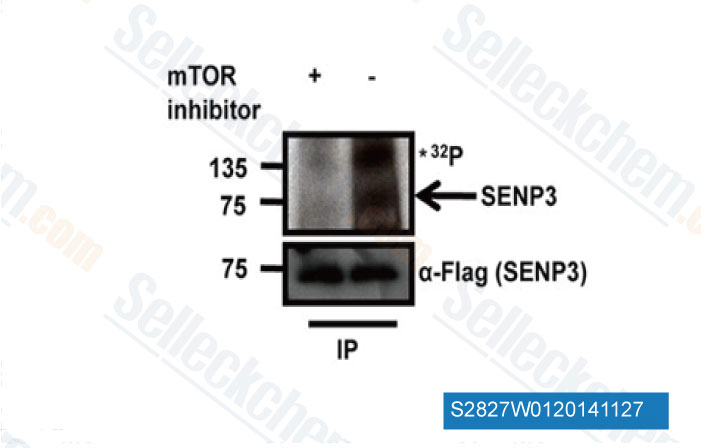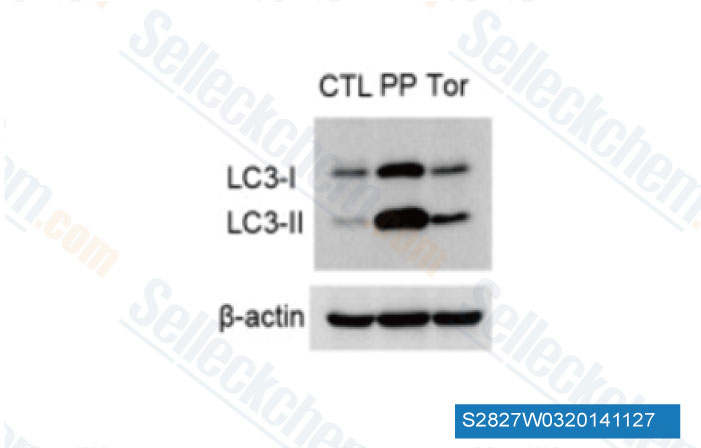|
Toll Free: (877) 796-6397 -- USA and Canada only -- |
Fax: +1-832-582-8590 Orders: +1-832-582-8158 |
Tech Support: +1-832-582-8158 Ext:3 Please provide your Order Number in the email. |
Technical Data
| Formula | C35H28F3N5O2 |
|||
| Molecular Weight | 607.62 | CAS No. | 1222998-36-8 | |
| Solubility (25°C)* | In vitro | DMSO | 2 mg/mL (3.29 mM) | |
| Water | Insoluble | |||
| Ethanol | Insoluble | |||
|
* <1 mg/ml means slightly soluble or insoluble. * Please note that Selleck tests the solubility of all compounds in-house, and the actual solubility may differ slightly from published values. This is normal and is due to slight batch-to-batch variations. * Room temperature shipping (Stability testing shows this product can be shipped without any cooling measures.) |
||||
Preparing Stock Solutions
Biological Activity
| Description | Torin 1 is a potent inhibitor of mTORC1/2 with IC50 of 2 nM/10 nM in cell-free assays; exhibits 1000-fold selectivity for mTOR than PI3K. | |||||||||||
|---|---|---|---|---|---|---|---|---|---|---|---|---|
| Targets |
|
|||||||||||
| In vitro | Torin1 inhibits phosphorylation of mTORC1 and mTORC2 substrates in cells at concentrations of 2 and 10 nM, respectively. Moreover, Torin1 exhibits 1000-fold selectivity for mTOR over PI3K (EC50 = 1800 nM) and exhibits 100-fold binding selectivity relative to 450 other protein kinases. [1] [2] Torin1 causes cell cycle arrest through a rapamycin-resistant mechanism that is also independent of mTORC2. Torin1 disrupts mTORC1-dependent phenotypes more completely than rapamycin. Rapamycin-resistant functions of mTORC1 are required for cap-dependent translation. [1] In a recent study, it is reported Torin1 increases neurotensin secretion and gene expression through activation of the MEK/ERK/c-Jun pathway in the human endocrine cell line BON. [3] | |||||||||||
| In vivo | Torin1 is efficacious at a dose of 20 mg/kg in a U87MG xenograft model and demonstrates good pharmacodynamic inhibition of downstream effectors of mTOR in tumor and peripheral tissues. [2] |
Protocol (from reference)
| Kinase Assay:[1] |
|
|---|---|
| Cell Assay:[1] |
|
| Animal Study:[2] |
|
References
Customer Product Validation

-
Data from [Data independently produced by Am J Pathol, 2014, 184(1), 214-29]

-
Data from [Data independently produced by Mol Cell Biol, 2014, 34(24), 4474-84]

-
Data from [Data independently produced by Biochem Biophys Res Commun, 2014, 10.1016/j.bbrc.2014.05.047]

-
Data independently produced by , , Lim Hsiu Kim, Lina from National University of Singapore
Selleck's Torin 1 has been cited by 236 publications
| Akt enhances the vulnerability of cancer cells to VCP/p97 inhibition-mediated paraptosis [ Cell Death Dis, 2024, 15(1):48] | PubMed: 38218922 |
| MTOR Suppresses Cigarette Smoke-Induced Airway Inflammation and MMP12 Expression in Macrophage in Chronic Obstructive Pulmonary Disease [ Int J Chron Obstruct Pulmon Dis, 2024, 19:269-279] | PubMed: 38288346 |
| Lysosomes mediate the mitochondrial UPR via mTORC1-dependent ATF4 phosphorylation [ Cell Discov, 2023, 9(1):92] | PubMed: 37679337 |
| Lysosomes mediate the mitochondrial UPR via mTORC1-dependent ATF4 phosphorylation [ Cell Discov, 2023, 9(1):92] | PubMed: 37679337 |
| PD-1 instructs a tumor-suppressive metabolic program that restricts glycolysis and restrains AP-1 activity in T cell lymphoma [ Nat Cancer, 2023, 4(10):1508-1525] | PubMed: 37723306 |
| Analysis of ATG4C function in vivo [ Autophagy, 2023, 19(11):2912-2933] | PubMed: 37459465 |
| Direct regulation of FNIP1 and FNIP2 by MEF2 sustains MTORC1 activation and tumor progression in pancreatic cancer [ Autophagy, 2023, 1-20.] | PubMed: 37772772 |
| Analysis of ATG4C function in vivo [ Autophagy, 2023, 19(11):2912-2933] | PubMed: 37459465 |
| SARS-CoV-2 ORF7a blocked autophagy flux by intervening in the fusion between autophagosome and lysosome to promote viral infection and pathogenesis [ J Med Virol, 2023, 10.1002/jmv.29200] | PubMed: 37916857 |
| NCoR1 controls Mycobacterium tuberculosis growth in myeloid cells by regulating the AMPK-mTOR-TFEB axis [ PLoS Biol, 2023, 21(8):e3002231] | PubMed: 37590294 |
RETURN POLICY
Selleck Chemical’s Unconditional Return Policy ensures a smooth online shopping experience for our customers. If you are in any way unsatisfied with your purchase, you may return any item(s) within 7 days of receiving it. In the event of product quality issues, either protocol related or product related problems, you may return any item(s) within 365 days from the original purchase date. Please follow the instructions below when returning products.
SHIPPING AND STORAGE
Selleck products are transported at room temperature. If you receive the product at room temperature, please rest assured, the Selleck Quality Inspection Department has conducted experiments to verify that the normal temperature placement of one month will not affect the biological activity of powder products. After collecting, please store the product according to the requirements described in the datasheet. Most Selleck products are stable under the recommended conditions.
NOT FOR HUMAN, VETERINARY DIAGNOSTIC OR THERAPEUTIC USE.
